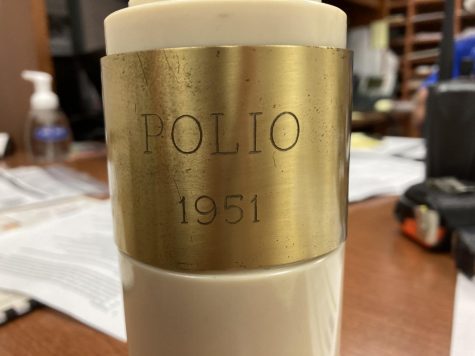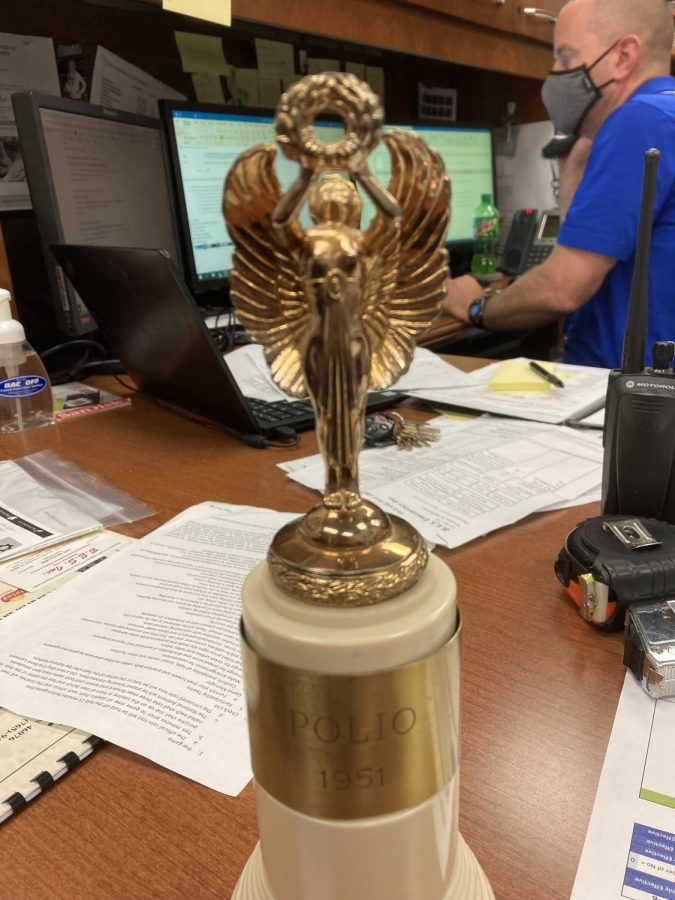Mystery of the polio trophy unraveled
Hundreds of students pass the Fieldhouse trophy case every day, without much notice of what is inside. Upon closer inspection, there are trophies of all kinds, from track and field wins, to basketball championship winners from 1964.
However, one trophy is very different from all the rest. It’s a gold trophy with a white stone base, and it supports a gilded angel upon its pointed crest, sitting right in front of many others. The strange thing about it is the two words engraved on its front, Polio and 1951.
The first word is odd enough on its own. Polio. A disease that ransacked the U.S in the 1940s and 50s, causing paralytic effects on children and adults alike. It created worldwide panic and distress, forcing the U.S to shut down swimming pools and schools to prevent the spread of the disease.
President Franklin D. Roosevelt even contracted it himself, confining him to a wheelchair for the second half of his life. Thankfully, polio passed quickly with the creation of the vaccine, and it is now in the past, but memories of it remain.
This disease was a painful time for America, as all diseases that affect children are, so why would this awful pathogen deserve some kind of award? What about this should be remembered with a trophy?
Then the date. 1951. This was at the peak of the polio pandemic, which brings to mind what could possibly be worth awarding. At first thought, the vaccine would come to mind.

It very well could be possible that this trophy was awarded for polio vaccines, whether it being the first or the last set of doses. This still poses questions, as 1951 was very late in the game for polio vaccines, as they were being widely dispersed in the late 40s. This could be possible as a trophy for vaccines, it’s just too hard to know for sure without any other evidence.
“It’s intriguing. We got it with the other stuff from Arcola and Huntertown,” said Mr. Ginder, the Athletics Director, when asked about the trophy’s origin, “Though I’m almost positive we got it from an Arcola person.”
“I remember pulling it out of a box of old trophies 10 or so years ago, and thought, huh, that’s a weird one, wonder what it’s from?” said Ginder.
Mr. Ginder also would like to send out a message to the students about the trophy cases.
“So many kids walk past it without even knowing what they are walking past. There are so many cool old trophies, pictures, and memorabilia for schools that these kids went to as elementary schoolers. They just have to stop and look to see the awesomeness inside those cases,” said Ginder.
Another connection was made with the Rotary club in Huntertown, which has done some Polio-related events in the past, which gives us an idea that the trophy is from Huntertown.
“I am a part of the Rotary Club, which has over 1.2 million members nationwide. We work to make communities better, and we partake in all kinds of things to benefit people all over the world. Most recently, we have spent many years working to eradicate polio worldwide, and thanks to our works we have pushed polio out of the empire continent of Africa,” said Chris Widner, a Rotary Club member.
The polio trophy interested the Rotary Club, as they had never seen anything like it.
“I have seen plaques and all kinds of awards before, but I’ve never seen a trophy. It’s truly a unique piece,” said Widner.
It being possibly one-of-a-kind makes this artifact more mysterious, as the Rotary club had given out plagues when they did fundraisers.
“I suspect that this trophy is from a money fundraiser done here in Fort Wayne, most likely by Riley’s Children’s Hospital, because polio was mainly attacking children. It was painful for people to see and go through because these little kids were being bedridden and killed by a disease that was highly contagious. Riley’s was huge in the 50s when it came to eradicating children’s polio, and they worked with the Rotary Club to alert people of the opportunities that allowed them to donate money to research against the disease,” said Widner.
This only widens the hole of mystery even more, as it poses the statement- out of 1.2 million Rotary Club members in the United States alone, not one of them knew of a trophy. It’s unique. Special. One of a kind. That means that Carroll High School could have a trophy that no one else in the United States does.
“This trophy makes me kind of proud and kind of confused, but not really surprised. See, I’m proud because one of our awards made it this long, as that trophy is almost 70 years old, and the fact that our work piqued the interest of a student in the school in which the award is displayed. It confuses me because normally our artifacts have more information than that. It’s odd, there’s something different about it that will require some digging to understand,” said Widner, when asked what his first reaction to the artifact was.
This trophy needs to be recognized, not only because of its importance in American history, but also because it had some kind of impact on the people in this area. Someone, or a group of people, collected enough money towards this cause that they deserved a trophy for it.
This had an impact on our community, and it has been forgotten by the students who do not pay attention to it every day when they walk past. Though this is a mystery, it is important history that many people care about, and students should care about it too.
It leads people to wonder, what other school artifacts have odd, wild, and wonderful backstories behind them?

Madison is a 15 and a freshman, and she is excited about the opportunity that people will get to read her writing through this website. She enjoys reading,...





